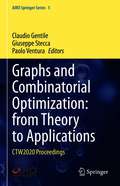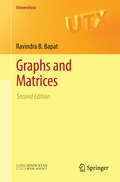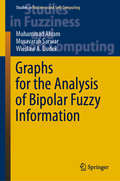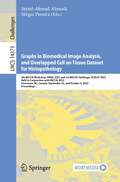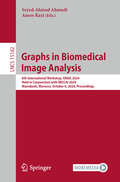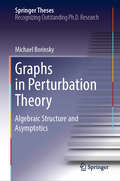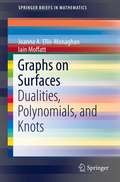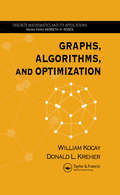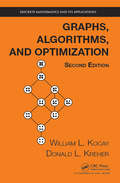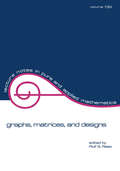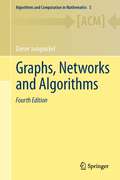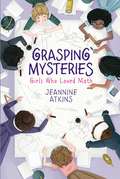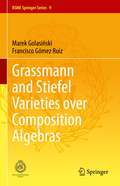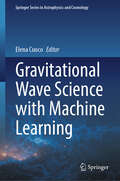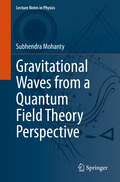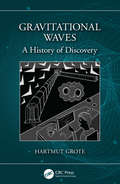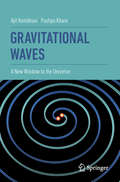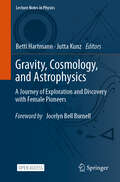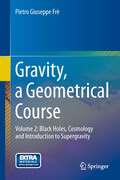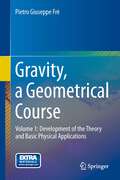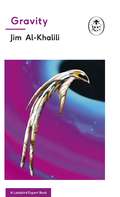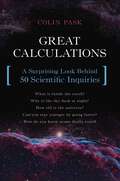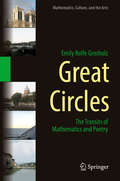- Table View
- List View
Graphs and Combinatorial Optimization: CTW2020 Proceedings (AIRO Springer Series #5)
by Claudio Gentile Giuseppe Stecca Paolo VenturaThis book highlights new and original contributions on Graph Theory and Combinatorial Optimization both from the theoretical point of view and from applications in all fields. The book chapters describe models and methods based on graphs, structural properties, discrete optimization, network optimization, mixed-integer programming, heuristics, meta-heuristics, math-heuristics, and exact methods as well as applications. The book collects selected contributions from the CTW2020 international conference (18th Cologne-Twente Workshop on Graphs and Combinatorial Optimization), held online on September 14-16, 2020. The conference was organized by IASI-CNR with the contribution of University of Roma Tre, University Roma Tor Vergata, and CNRS-LIX and with the support of AIRO. It is addressed to researchers, PhD students, and practitioners in the fields of Graph Theory, Discrete Mathematics, Combinatorial Optimization, and Operations Research.
Graphs and Matrices
by Ravindra B. BapatThis new edition illustrates the power of linear algebra in the study of graphs. The emphasis on matrix techniques is greater than in other texts on algebraic graph theory. Important matrices associated with graphs (for example, incidence, adjacency and Laplacian matrices) are treated in detail. Presenting a useful overview of selected topics in algebraic graph theory, early chapters of the text focus on regular graphs, algebraic connectivity, the distance matrix of a tree, and its generalized version for arbitrary graphs, known as the resistance matrix. Coverage of later topics include Laplacian eigenvalues of threshold graphs, the positive definite completion problem and matrix games based on a graph. Such an extensive coverage of the subject area provides a welcome prompt for further exploration. The inclusion of exercises enables practical learning throughout the book. In the new edition, a new chapter is added on the line graph of a tree, while some results in Chapter 6 on Perron-Frobenius theory are reorganized. Whilst this book will be invaluable to students and researchers in graph theory and combinatorial matrix theory, it will also benefit readers in the sciences and engineering.
Graphs for the Analysis of Bipolar Fuzzy Information (Studies in Fuzziness and Soft Computing #401)
by Muhammad Akram Musavarah Sarwar Wieslaw A. DudekThis monograph discusses decision making methods under bipolar fuzzy graphical models with the aim of overcoming the lack of mathematical approach towards bipolar information—positive and negative. It investigates the properties of bipolar fuzzy graphs, their distance functions, and concept of their isomorphism. It presents certain notions, including irregular bipolar fuzzy graphs, domination in bipolar fuzzy graphs, bipolar fuzzy circuits, energy in bipolar fuzzy graphs, bipolar single-valued neutrosophic competition graphs, and bipolar neutrosophic graph structures. This book also presents the applications of mentioned concepts to real-world problems in areas of product manufacturing, international relations, psychology, global terrorism and more, making it valuable for researchers, computer scientists, social scientists and alike.
Graphs in Biomedical Image Analysis, and Overlapped Cell on Tissue Dataset for Histopathology: 5th MICCAI Workshop, GRAIL 2023 and 1st MICCAI Challenge, OCELOT 2023, Held in Conjunction with MICCAI 2023, Vancouver, BC, Canada, September 23, and October 4, 2023, Proceedings (Lecture Notes in Computer Science #14373)
by Seyed-Ahmad Ahmadi Sérgio PereiraThis LNCS conference volume constitutes the proceedings of the MICCAI Workshop GRAIL 2023 and MICCAI Challenge OCELOT 2023, Held in Conjunction with MICCAI 2023, Vancouver, BC, Canada, September 23, and October 4, 2023. The 9 full papers (GRAIL 2023) and 6 full papers (OCELOT 2023) included in this volume were carefully reviewed and selected from GRAIL 14 (GRAIL 2023) and 6 (OCELOT 2023) submissions. The conference GRAIL 2023 a wide set of methods and application and OCELOT 2023 focuses on the cover a wide range of methods utilizing tissue information for better cell detection, in the sense of training strategy, model architecture, and especially how to model cell-tissue relationships.
Graphs in Biomedical Image Analysis: 6th International Workshop, GRAIL 2024, Held in Conjunction with MICCAI 2024, Marrakesh, Morocco, October 6, 2024, Proceedings (Lecture Notes in Computer Science #15182)
by Seyed-Ahmad Ahmadi Anees KaziThis book constitutes the refereed proceedings of the 6th International Workshop on Graphs in Biomedical Image Analysis, GRAIL 2024, held in conjunction with MICCAI 2024, in Marrakesh, Morocco, on October 6, 2024. The 12 full papers included in this volume were carefully reviewed and selected from 19 submissions. The papers cover a wide range of topics, such as deep/machine learning on graphs; probabilistic graphical models for biomedical data analysis; signal processing on graphs for biomedical image analysis; explainable AI (XAI) methods in geometric deep learning; big data analysis with graphs; graphs for small data sets; semantic graph research in medicine; modeling and applications of graph symmetry/equivariance; or graph generative models.
Graphs in Perturbation Theory: Algebraic Structure And Asymptotics (Springer Theses)
by Michael BorinskyThis book is the first systematic study of graphical enumeration and the asymptotic algebraic structures in perturbative quantum field theory. Starting with an exposition of the Hopf algebra structure of generic graphs, it reviews and summarizes the existing literature. It then applies this Hopf algebraic structure to the combinatorics of graphical enumeration for the first time, and introduces a novel method of asymptotic analysis to answer asymptotic questions. This major breakthrough has combinatorial applications far beyond the analysis of graphical enumeration. The book also provides detailed examples for the asymptotics of renormalizable quantum field theories, which underlie the Standard Model of particle physics. A deeper analysis of such renormalizable field theories reveals their algebraic lattice structure. The pedagogical presentation allows readers to apply these new methods to other problems, making this thesis a future classic for the study of asymptotic problems in quantum fields, network theory and far beyond.
Graphs on Surfaces: Dualities, Polynomials, and Knots
by Joanna A. Ellis-Monaghan Iain MoffattGraphs on Surfaces: Dualities, Polynomials, and Knots offers an accessible and comprehensive treatment of recent developments on generalized duals of graphs on surfaces, and their applications. The authors illustrate the interdependency between duality, medial graphs and knots; how this interdependency is reflected in algebraic invariants of graphs and knots; and how it can be exploited to solve problems in graph and knot theory. Taking a constructive approach, the authors emphasize how generalized duals and related ideas arise by localizing classical constructions, such as geometric duals and Tait graphs, and then removing artificial restrictions in these constructions to obtain full extensions of them to embedded graphs. The authors demonstrate the benefits of these generalizations to embedded graphs in chapters describing their applications to graph polynomials and knots. Graphs on Surfaces: Dualities, Polynomials, and Knots also provides a self-contained introduction to graphs on surfaces, generalized duals, topological graph polynomials, and knot polynomials that is accessible both to graph theorists and to knot theorists. Directed at those with some familiarity with basic graph theory and knot theory, this book is appropriate for graduate students and researchers in either area. Because the area is advancing so rapidly, the authors give a comprehensive overview of the topic and include a robust bibliography, aiming to provide the reader with the necessary foundations to stay abreast of the field. The reader will come away from the text convinced of advantages of considering these higher genus analogues of constructions of plane and abstract graphs, and with a good understanding of how they arise.
Graphs!
by David A. AdlerMath booster author David A. Adler and artist Ed Miller make pie charts easy-as-pie charts with this fun and vibrantly illustrated guide to data collection.For students, STEM topics don&’t always feel like a walk in the park. But what if they were more like a day at the fair? Follow Janet and Ben from the Ferris Wheel to the carousel as they use graphs and data collection to make decisions about their day. This is the sixteenth book in this duo&’s math picture book series. Combining elements of a graphic story with engaging and accessible nonfiction text, David A. Adler combines his well-established STEM know-how with Edward Miller&’s vibrant, high contrast art to take young readers on a wild ride through the world of bar graphs, pictographs, pie charts, and more!
Graphs, Algorithms, and Optimization (Discrete Mathematics and Its Applications)
by William Kocay Donald L. Kreher<p>Graph theory offers a rich source of problems and techniques for programming and data structure development, as well as for understanding computing theory, including NP-Completeness and polynomial reduction. A comprehensive text, Graphs, Algorithms, and Optimization features clear exposition on modern algorithmic graph theory presented in a rigorous yet approachable way. The book covers major areas of graph theory including discrete optimization and its connection to graph algorithms. The authors explore surface topology from an intuitive point of view and include detailed discussions on linear programming that emphasize graph theory problems useful in mathematics and computer science. Many algorithms are provided along with the data structure needed to program the algorithms efficiently. <p>The book also provides coverage on algorithm complexity and efficiency, NP-completeness, linear optimization, and linear programming and its relationship to graph algorithms.Written in an accessible and informal style, this work covers nearly all areas of graph theory. Graphs, Algorithms, and Optimization provides a modern discussion of graph theory applicable to mathematics, computer science, and crossover applications.</p>
Graphs, Algorithms, and Optimization (Discrete Mathematics and Its Applications)
by William Kocay Donald L. KreherThe second edition of this popular book presents the theory of graphs from an algorithmic viewpoint. The authors present the graph theory in a rigorous, but informal style and cover most of the main areas of graph theory. The ideas of surface topology are presented from an intuitive point of view. We have also included a discussion on linear programming that emphasizes problems in graph theory. The text is suitable for students in computer science or mathematics programs.
Graphs, Matrices, and Designs: Festschrift In Honor Of Norman J. Pullman
by ReesExamines partitions and covers of graphs and digraphs, latin squares, pairwise balanced designs with prescribed block sizes, ranks and permanents, extremal graph theory, Hadamard matrices and graph factorizations. This book is designed to be of interest to applied mathematicians, computer scientists and communications researchers.
Graphs, Networks and Algorithms
by Dieter JungnickelFrom the reviews of the previous editions ".... The book is a first class textbook and seems to be indispensable for everybody who has to teach combinatorial optimization. It is very helpful for students, teachers, and researchers in this area. The author finds a striking synthesis of nice and interesting mathematical results and practical applications. ... the author pays much attention to the inclusion of well-chosen exercises. The reader does not remain helpless; solutions or at least hints are given in the appendix. Except for some small basic mathematical and algorithmic knowledge the book is self-contained. ..." K.Engel, Mathematical Reviews 2002 The substantial development effort of this text, involving multiple editions and trailing in the context of various workshops, university courses and seminar series, clearly shows through in this new edition with its clear writing, good organisation, comprehensive coverage of essential theory, and well-chosen applications. The proofs of important results and the representation of key algorithms in a Pascal-like notation allow this book to be used in a high-level undergraduate or low-level graduate course on graph theory, combinatorial optimization or computer science algorithms. The well-worked solutions to exercises are a real bonus for self study by students. The book is highly recommended. P .B. Gibbons, Zentralblatt für Mathematik 2005 Once again, the new edition has been thoroughly revised. In particular, some further material has been added: more on NP-completeness (especially on dominating sets), a section on the Gallai-Edmonds structure theory for matchings, and about a dozen additional exercises - as always, with solutions. Moreover, the section on the 1-factor theorem has been completely rewritten: it now presents a short direct proof for the more general Berge-Tutte formula. Several recent research developments are discussed and quite a few references have been added.
Grasping Mysteries: Girls Who Loved Math
by Jeannine AtkinsLearn about seven groundbreaking women in math and science in this gorgeously written biographical novel-in-verse, a companion to the &“original and memorable&” (Booklist, starred review) Finding Wonders: Three Girls Who Changed Science.After a childhood spent looking up at the stars, Caroline Herschel was the first woman to discover a comet and to earn a salary for scientific research. Florence Nightingale was a trailblazing nurse whose work reformed hospitals and one of the founders of the field of medical statistics. The first female electrical engineer, Hertha Marks Ayrton registered twenty-six patents for her inventions. Marie Tharp helped create the first map of the entire ocean floor, which helped scientists understand our subaquatic world and suggested how the continents shifted. A mathematical prodigy, Katherine Johnson calculated trajectories and launch windows for many NASA projects including the Apollo 11 mission. Edna Lee Paisano, a citizen of the Nez Perce Nation, was the first Native American to work full time for the Census Bureau, overseeing a large increase in American Indian and Alaskan Native representation. And Vera Rubin studied more than two hundred galaxies and found the first strong evidence for dark matter. Told in vibrant, evocative poems, this stunning novel celebrates seven remarkable women who used math as their key to explore the mysteries of the universe and grew up to do innovative work that changed the world.
Grassmann and Stiefel Varieties over Composition Algebras (RSME Springer Series #9)
by Marek Golasiński Francisco Gómez RuizThis monograph deals with matrix manifolds, i.e., manifolds for which there is a natural representation of their elements as matrix arrays. Classical matrix manifolds (Stiefel, Grassmann and flag manifolds) are studied in a more general setting. It provides tools to investigate matrix varieties over Pythagorean formally real fields. The presentation of the book is reasonably self-contained. It contains a number of nontrivial results on matrix manifolds useful for people working not only in differential geometry and Riemannian geometry but in other areas of mathematics as well. It is also designed to be readable by a graduate student who has taken introductory courses in algebraic and differential geometry.
Gravitational Wave Science with Machine Learning (Springer Series in Astrophysics and Cosmology)
by Elena CuocoThis book highlights the state of the art of machine learning applied to the science of gravitational waves. The main topics of the book range from the search for astrophysical gravitational wave signals to noise suppression techniques and control systems using machine learning-based algorithms. During the four years of work in the COST Action CA17137-A network for Gravitational Waves, Geophysics and Machine Learning (G2net), the collaboration produced several original publications as well as tutorials and lectures in the training schools we organized. The book encapsulates the immense amount of finding and achievements. It is a timely reference for young researchers approaching the analysis of data from gravitational wave experiments, with alternative approaches based on the use of artificial intelligence techniques.
Gravitational Waves from a Quantum Field Theory Perspective (Lecture Notes in Physics #1013)
by Subhendra MohantyThis book treats the subject of gravitational waves (GWs) production in binary stars or black-holes and in the early universe, using tools of quantum field theory which are familiar to graduate students and researchers in particle physics. A special focus is given to the generation of templates of gravitational wave signals from Feynman diagram calculations of transition amplitudes, which interests active researchers in GWs. The book presents field theory concepts, like supersymmetry realized in spinning binaries and soft-graviton theorems, that can have practical applications in novel GW signals, like the memory effect. The book also aims at specialists in both GWs and particle physics addressing cosmological models of phase transition and inflation that can be tested in observations at terrestrial and space based interferometers, pulsar timing arrays, and the cosmic microwave anisotropy observations.
Gravitational Waves: A History of Discovery
by Hartmut GroteThe historic detection of gravitational waves on September 14, 2015, prompted by the highly energetic fusion of two black holes, has made events in the universe "audible" for the first time. This expansion of the scientific sensorium has opened a new chapter in astronomy and already led to, among others, fascinating new insights about the abundance of black holes, the collision of neutron stars, and the origin of heavy chemical elements. The history of this event, which is epochal for physics, is reconstructed in this book, along with a walk-through of the main principles of how the detectors operate and a discussion of how the search for gravitational waves is conducted. The book concludes with an update of the latest detections and developments to date and a brief look into the future of this exciting research field. This book is accessible to non-specialist readers from a general audience and is also an excellent introduction to the topic for undergraduates in physics. Features: Provides an introduction to the historic discovery of gravitational waves Explains the inner workings of the detectors and the search to find the waves hidden in the data Authored by a renowned specialist involved in the ground-breaking discovery Hartmut Grote is a Professor of physics at Cardiff University, UK. His main expertise is in experimental gravitational-wave physics, and he has worked on building and improving gravitational wave detectors for over 20 years. From 2009 to 2017, he was the scientific leader of the British-German gravitational-wave detector: GEO600.
Gravitational Waves: A New Window to the Universe
by Ajit Kembhavi Pushpa KhareGravitational waves were first predicted by Albert Einstein in 1916, a year after the development of his new theory of gravitation known as the general theory of relativity. This theory established gravitation as the curvature of space-time produced by matter and energy. To be discernible even to the most sensitive instruments on Earth, the waves have to be produced by immensely massive objects like black holes and neutron stars which are rotating around each other, or in the extreme situations which prevail in the very early ages of the Universe. This book presents the story of the prediction of gravitational waves by Albert Einstein, the early attempts to detect the waves, the development of the LIGO detector, the first detection in 2016, the subsequent detections and their implications. All concepts are described in some detail, without the use of any mathematics and advanced physics which are needed for a full understanding of the subject. The book also contains description of electromagnetism, Einstein’s special theory and general theory of relativity, white dwarfs, neutron stars and black holes and other concepts which are needed for understanding gravitational waves and their effects. Also described are the LIGO detectors and the cutting edge technology that goes into building them, and the extremely accurate measurements that are needed to detect gravitational waves. The book covers these ideas in a simple and lucid fashion which should be accessible to all interested readers. The first detection of gravitational waves was given a lot of space in the print and electronic media. So, the curiosity of the non-technical audience has been aroused about what gravitational waves really are and why they are so important. This book seeks to answer such questions.
Gravity, Cosmology, and Astrophysics: A Journey of Exploration and Discovery with Female Pioneers (Lecture Notes in Physics #1022)
by Betti Hartmann Jutta KunzThis book is a compilation of enlightening tutorial essays, showcasing the forefront of research by exceptional female scientists. This invaluable collection provides graduate students and researchers in the field with an engaging and pedagogical introduction to a wide range of compelling topics. Delve into the depths of theoretical and observational realms, exploring intriguing subjects including modified gravity models, quantum gravity, fields in curved space-time, particle dynamics, gravitational waves, and enigmatic black holes. Embracing both the theoretical foundations and the practical applications, this comprehensive edited volume offers an accessible and all-encompassing panorama of gravity and cosmology. Moreover, it shines a much-needed spotlight on the significant contributions made by remarkable women across the globe, fostering recognition and admiration for their indispensable role in shaping this ever-evolving field.
Gravity, a Geometrical Course
by Pietro Giuseppe Frè'Gravity, a Geometrical Course' presents general relativity (GR) in a systematic and exhaustive way, covering three aspects that are homogenized into a single texture: i) the mathematical, geometrical foundations, exposed in a self consistent contemporary formalism, ii) the main physical, astrophysical and cosmological applications, updated to the issues of contemporary research and observations, with glimpses on supergravity and superstring theory, iii) the historical development of scientific ideas underlying both the birth of general relativity and its subsequent evolution. The book is divided in two volumes. Volume Two is covers black holes, cosmology and an introduction to supergravity. The aim of this volume is two-fold. It completes the presentation of GR and it introduces the reader to theory of gravitation beyond GR, which is supergravity. Starting with a short history of the black hole concept, the book covers the Kruskal extension of the Schwarzschild metric, the causal structures of Lorentzian manifolds, Penrose diagrams and a detailed analysis of the Kerr-Newman metric. An extensive historical account of the development of modern cosmology is followed by a detailed presentation of its mathematical structure, including non-isotropic cosmologies and billiards, de Sitter space and inflationary scenarios, perturbation theory and anisotropies of the Cosmic Microwave Background. The last three chapters deal with the mathematical and conceptual foundations of supergravity in the frame of free differential algebras. Branes are presented both as classical solutions of the bulk theory and as world-volume gauge theories with particular emphasis on the geometrical interpretation of kappa-supersymmetry. The rich bestiary of special geometries underlying supergravity lagrangians is presented, followed by a chapter providing glances on the equally rich collection of special solutions of supergravity. Pietro Frè is Professor of Theoretical Physics at the University of Torino, Italy and is currently serving as Scientific Counsellor of the Italian Embassy in Moscow. His scientific passion lies in supergravity and all allied topics, since the inception of the field, in 1976. He was professor at SISSA, worked in the USA and at CERN. He has taught General Relativity for 15 years. He has previously two scientific monographs, "Supergravity and Superstrings" and "The N=2 Wonderland", He is also the author of a popular science book on cosmology and two novels, in Italian.
Gravity, a Geometrical Course: Development of the Theory and Basic Physical Applications
by Pietro Giuseppe Frè'Gravity, a Geometrical Course' presents general relativity (GR) in a systematic and exhaustive way, covering three aspects that are homogenized into a single texture: i) the mathematical, geometrical foundations, exposed in a self consistent contemporary formalism, ii) the main physical, astrophysical and cosmological applications, updated to the issues of contemporary research and observations, with glimpses on supergravity and superstring theory, iii) the historical development of scientific ideas underlying both the birth of general relativity and its subsequent evolution. The book, divided in two volumes, is a rich resource for graduate students and those who wish to gain a deep knowledge of the subject without an instructor. Volume One is dedicated to the development of the theory and basic physical applications. It guides the reader from the foundation of special relativity to Einstein field equations, illustrating some basic applications in astrophysics. A detailed account of the historical and conceptual development of the theory is combined with the presentation of its mathematical foundations. Differentiable manifolds, fibre-bundles, differential forms, and the theory of connections are covered, with a sketchy introduction to homology and cohomology. (Pseudo)-Riemannian geometry is presented both in the metric and in the vielbein approach. Physical applications include the motions in a Schwarzschild field leading to the classical tests of GR (light-ray bending and periastron advance) discussion of relativistic stellar equilibrium, white dwarfs, Chandrasekhar mass limit and polytropes. An entire chapter is devoted to tests of GR and to the indirect evidence of gravitational wave emission. The formal structure of gravitational theory is at all stages compared with that of non gravitational gauge theories, as a preparation to its modern extension, namely supergravity, discussed in the second volume. Pietro Frè is Professor of Theoretical Physics at the University of Torino, Italy and is currently serving as Scientific Counsellor of the Italian Embassy in Moscow. His scientific passion lies in supergravity and all allied topics, since the inception of the field, in 1976. He was professor at SISSA, worked in the USA and at CERN. He has taught General Relativity for 15 years. He has previously two scientific monographs, "Supergravity and Superstrings" and "The N=2 Wonderland", He is also the author of a popular science book on cosmology and two novels, in Italian.
Gravity: A Ladybird Expert Book
by Jim Al-KhaliliHow does gravity work? Learn from the experts in the ALL-NEW LADYBIRD EXPERT SERIESDiscover the vast and momentus effects of this profound force on the world around us, written by celebrated physicist and broadcaster Jim Al-Khalili.Inside you will learn:- What is Gravity?- How does it work?- And why are there extreme gravitational environments?Above all, discover how gravity controls the shape of space and the passage of time itself, influencing the history and destiny of the entire Universe.IT'S SO MUCH MORE THAN 'WHAT GOES UP MUST COME DOWN.'Gravity is a fascinating and authoritative introduction to a phenomenon as familiar to us as breathing.Learn about other topics in the Ladybird Experts series including The Big Bang, Quantum Physics, Climate Change and Evolution.
Gray Dawn: How the Coming Age Will Transform America and the World
by Peter G. PetersonHow Aging is changing our world.
Great Calculations: A Surprising Look Behind 50 Scientific Inquiries
by Colin PaskScience is based not only on observation and experiment, but on theory as well. As Einstein said, "Theory tells us what to measure." And theories are often crystallized into succinct calculations, like those made using Einstein's famous E = mc2. This book looks at fifty such great calculations, exploring how and why they were developed and assessing their impact on the history of science. As the author shows, many significant scientific calculations are quite simple and fairly easy to understand, even for readers will little math background. But their implications can be surprising and profound. For example, what links a famous comet and the cost of an annuity? Why do scientists claim there is "dark matter" in the universe if it can't be observed? How does carbon-based life on Earth depend on a quirk of nuclear physics? The answer to each question is an illuminating calculation. This accessible, engaging book will help you understand these breakthroughs and how they changed our view of life and the world.
Great Circles: The Transits of Mathematics and Poetry (Mathematics, Culture, and the Arts)
by Emily Rolfe GrosholzThis volume explores the interaction of poetry and mathematics by looking at analogies that link them. The form that distinguishes poetry from prose has mathematical structure (lifting language above the flow of time), as do the thoughtful ways in which poets bring the infinite into relation with the finite. The history of mathematics exhibits a dramatic narrative inspired by a kind of troping, as metaphor opens, metonymy and synecdoche elaborate, and irony closes off or shifts the growth of mathematical knowledge. The first part of the book is autobiographical, following the author through her discovery of these analogies, revealed by music, architecture, science fiction, philosophy, and the study of mathematics and poetry. The second part focuses on geometry, the circle and square, launching us from Shakespeare to Housman, from Euclid to Leibniz. The third part explores the study of dynamics, inertial motion and transcendental functions, from Descartes to Newton, and in 20th c. poetry. The final part contemplates infinity, as it emerges in modern set theory and topology, and in contemporary poems, including narrative poems about modern cosmology.
